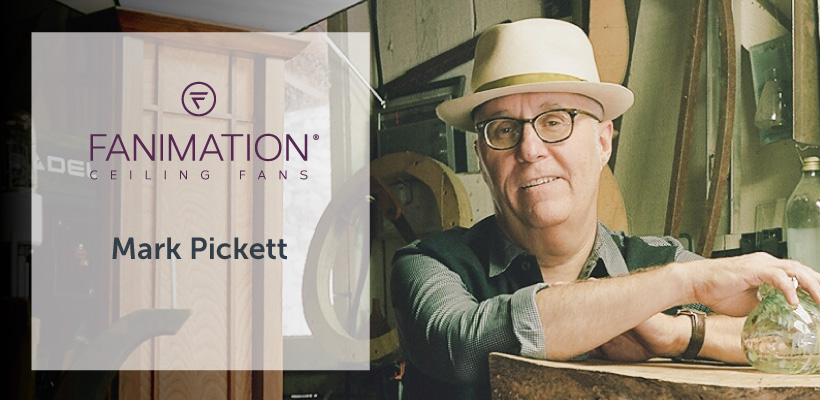Ever wonder what inspires our fan design? The answer to that question is as unique as our fans. There’s a story behind every fan. One of our design collaborators shares what inspires and informs his design concepts. Enjoy this Q&A with Mark Pickett.
Tell us a little about your background.
“I grew up in Arcadia, Indiana, a small Midwestern town that had two grocery stores, a dime store and my family’s hardware store. I worked at the hardware as a teenager and was always inspired by how things were made. From an early age I was making things, crafting silver jewelry, tooling leather and building furniture. In high school, I discovered the work of Charles and Ray Eames for Herman Miller furniture and the great modernist Marcel Bruer. I became an industrial designer because I wanted to design furniture. Ironically, it was almost 20 years before I designed my first furniture collection.”
How did you get started in product design?
“Before graduating from the University of Cincinnati, I worked in the Sears Tower as an industrial designer. My entrée into lighting started with Forecast Lighting in 1985. There I learned the lighting business by designing custom fixtures for the contract and hospitality market. I spent time as an in-house designer with Thomas Lighting, Minka Aire and CSL Lighting. In 1999, I started Smyth & Pickett with my wife and partner, Maryrose Smyth, to consult on the design of home furnishings and interiors.”
Tell us about your latest Fanimation design—aptly named, Pickett.
“The Pickett has a definite industrial/hardware look—black iron with brushed nickel or satin brass accents. My days in the hardware store clearly influenced the details of this fan. Maryrose defines the look as ‘inspired, turn-of-the-century American factory.’ Diane Keaton just released a new book, The House that Pinterest Built. It features her interpretation of this look for her new home in LA. The Pickett looks as if it were designed specifically for her project.”
Describe your working relationship with Fanimation.
“Collaboration is the key to working with all clients. My work with Fanimation is a perfect example of this process. The best scenario is sharing customer insights, trend observations and thoughts on market direction. The concepts flow from there and we continue to collaborate. It’s about listening and responding.”
How have fans and lighting changed since you first began?
“I believe that we all need a daily escape from our connected lives. This can be done by creating a place at home that is our own. It might be the communal table, the front porch or a garden folly. Design is in our daily lives as never before. Design has become a pastime for all.”
What’s popular right now?
“Modern, clean, geometric forms. I read a comment yesterday about how millennials are choosing more contemporary looks, but they are blending this with furniture handed down from their parents. We’re seeing it in old-school/factory—clean utilitarian looks produced with rich natural materials that impart a sense of history. Mid-century design is also popular. It has natural wood furnishings with brass accents, but it has to be a rich brass used as a discreet accent.”
Tell us something interesting about your connection to Fanimation.
“Fanimation was originally based in Pasadena, California and moved to Indiana. I moved from Indiana to California after college. My office is now in Pasadena.”
Tell us a peculiar fact about your career.
“My first job out of college was designing chainsaws.”
Where do you live?
“My family and I live in a 1920s Craftsman cottage with a barn in a secluded canyon in Altadena, California.”
Tell us about your design approach.
“My job is to listen. Then connect to my creativity for a solution.”
See Mark’s design at Fanimation.com: Pickett and Pickett Drum




Hi Mark, Glad to see you are designing for Fanimation…My Favorite!
I can’t wait to see it.
Hope you are well. Reading your bio is a trip down memory lane.